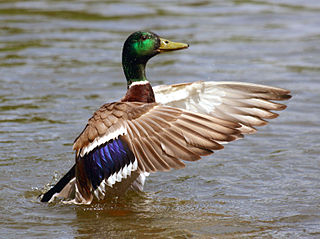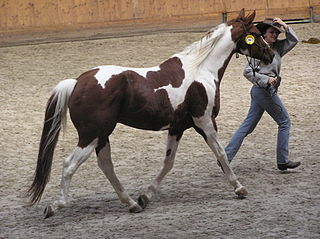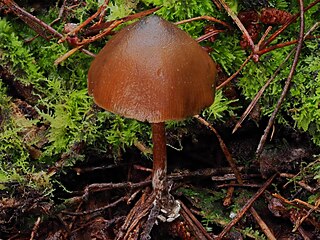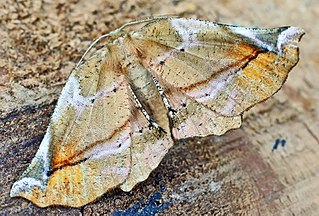
The greater white-fronted goose is a species of goose that is closely related to the smaller lesser white-fronted goose. The greater white-fronted goose is migratory, breeding in northern Canada, Alaska, Greenland and Russia, and winters farther south in North America, Europe and Asia. It is named for the patch of white feathers bordering the base of its bill: albifrons comes from the Latin albus "white" and frons "forehead". In the United Kingdom and Ireland, it has been known as the white-fronted goose; in North America it is known as the greater white-fronted goose, and this name is also increasingly adopted internationally. Even more distinctive are the salt-and-pepper markings on the breast of adult birds, which is why the goose is colloquially called the "specklebelly" in North America.

The speculum is a patch, often distinctly coloured, on the secondary wing feathers, or remiges, of some birds.

The hooded merganser is a species of fish-eating duck in the subfamily Anatinae. It is the only extant species in the genus Lophodytes. The genus name derives from the Greek language: lophos meaning 'crest', and dutes meaning 'diver'. The bird is striking in appearance; both sexes have crests that they can raise or lower, and the breeding plumage of the male is handsomely patterned and coloured. The hooded merganser has a sawbill but is not classified as a typical merganser.

Skewbald is a colour pattern of horses. A skewbald horse has a coat made up of white patches on a non-black base coat, such as chestnut, bay, or any colour besides black coat. Skewbald horses which are bay and white are sometimes called tricoloured. These horses usually have pink skin under white markings and dark skin under non-white areas. Other than colour, it is similar in appearance to the piebald pattern. Some animals also exhibit colouration of the irises of the eye that match the surrounding skin. The underlying genetic cause is related to a condition known as leucism. The term is also used to describe spotting patterns in various other animals, such as goats.

Tri-coloured refers to a horse with three different coat colours in a pinto spotting pattern of large white and dark patches, usually bay and white. This colouring is also commonly called skewbald. In modern usage in British English, skewbald and piebald horses are collectively referred to as coloured, while in North American English, the term pinto is used to describe the colour pattern.

A wine glass is a type of glass that is used for drinking or tasting wine. Most wine glasses are stemware (goblets), i.e., they are composed of three parts: the bowl, stem, and foot.

Clanwilliam is a town in the Olifants River valley in the Western Cape, South Africa, about 200 kilometres (120 mi) north of Cape Town. It is located in, and the seat of, the Cederberg Local Municipality. As of 2011 Clanwilliam had a population of 7,674.

Psilocybe aucklandiae is a species of agaric fungus in the family Hymenogastraceae. The species is known from the Auckland Region of New Zealand, where it grows from clay soils in exotic pine plantations and native forests. It is phylogenetically similar to or almost the same as Psilocybe zapotecorum from Mexico and South America. As a blueing member of the genus Psilocybe it contains the psychoactive compounds psilocin and psilocybin.

Ecliptopera silaceata, the small phoenix, is a moth of the family Geometridae. The species was first described by Michael Denis and Ignaz Schiffermüller in 1775.

Hylaea fasciaria, the barred red, is a species of moth in the family Geometridae. The species can be found in central and northern Europe, the Urals, Caucasus, Altai and eastern Siberia.

Apeira syringaria, the lilac beauty, is a moth of the family Geometridae. It is found throughout Europe and east across the Palearctic to the Russian Far East and Japan.

Anaplectoides prasina is a species of moth of the family Noctuidae. It is found in both the Palearctic and Nearctic realms.

Euphyia unangulata, the sharp-angled carpet, is a moth of the family Geometridae. It shares its common name with the similarly coloured Neoarctic, Euphyia intermediata.

Zygaena punctum is a species of moth in the family Zygaenidae. It is found in Poland, the Czech Republic, Slovakia, Austria, Slovenia, Italy, the Balkan Peninsula, Moldova, Ukraine, Russia and Turkey.

Lentinus strigosus is a species of fungus in the family Polyporaceae. It is edible when young, but becomes very tough with age.

Imbrasia epimethea is a species of moth belonging to the family Saturniidae. It was first described by Dru Drury in 1773 from the Calabar coast.

Cogia crameri is a species of butterfly in the family Hesperiidae, native to Central America and Suriname. It was described by Pieter Cramer in 1777 using the name Papilio orion, which was preoccupied. A replacement name honouring Cramer was designated in 1960.

Lobobunaea phaedusa is a species of very large moths in the family Saturniidae. It is found in much of sub-saharan Africa, where its host plants include African custard-apple, crown-berry, and Aframomum spp.
Cassinia monticola commonly known as mountain cassinia, is a species of flowering plant in the family Asteraceae and is endemic to mountain areas of south-eastern Australia. It is a spreading shrub with sticky, narrow linear to narrow lance-shaped leaves, and bronze-coloured to greenish-cream heads of flowers arranged in a dense, round-topped corymb.

Grapholita lunulana is a moth belonging to the family Tortricidae. The species was first described by Michael Denis and Ignaz Schiffermüller in 1775.


















